The Light Course
GA 320
Lecture III
25 December 1919, Stuttgart
My dear Friends,
I am told that the phenomenon with the prism—at the end of yesterday's lecture—has after all proved difficult for some of you to understand. Do not be troubled if this is so; you will understand it better by and by. We shall have to go into the phenomena of light and colour rather more fully. They are the real piece de resistance, even in relation to the rest of Physics, and will therefore provide a good foundation.
You will realize that the main idea of the present course is for me to tell you some of the things which you will not find in the text-books, things not included in the normal lines of the scientific study and only able to be dealt with in the way we do here. In the concluding lectures we shall consider how these reflections can also be made use of in school teaching.
What I was trying to explain is in its essence a special kind of interplay of light and dark—i.e. the unimpaired brightness and on the other hand the dimming or clouding of the light. I was trying to show how through the diverse ways in which light and dark work together—induced especially by the passage of a cylinder of light through a prism—the phenomena of colour, in all their polar relation to one-another, are brought about.
Now in the first place I really must ask you to swallow the bitter pill (I mean, those of you who found things difficult to understand). Your difficulty lies in the fact that you are always hankering after a phoronomical treatment of light and colour. The strange education we are made to undergo instils this mental habit. Thinking of outer Nature, people will restrict themselves to thoughts of a more or less phoronomical character. They will restrict their thoughts to what is arithmetical, spatially formal, and kinematical. Called on to try and think in terms of qualities as you are here, you may well be saying to yourselves: Here we get stuck! You must attribute it to the unnatural direction pursued by Science in modern time. Moreover—I speak especially to Waldorf-School and other teachers—you will yourselves to some extent still have to take the same direction with your pupils. It will not be possible, all at once, to bring the really healthy ideas into a modern school. We must find ways of transition.
For the phenomena of light and colour, let us now begin again, but from the other end. I take my start from a much disputed saying of Goethe's. In the 1780's a number of statements as to the way colours arise in and about the light came to his notice. Among other things, he learned of the prismatic phenomena we were beginning to study yesterday. It was commonly held by physicists, so Goethe learned, that when you let colourless light go through a prism the colourless light is analyzed and split up. For in some such way the phenomena were interpreted. If we let a cylinder of colourless light impinge on the screen, it shows a colourless picture. Putting a prism in the way of the cylinder of light, the physicists went on to say, we get the sequence of colours: red, orange, yellow, green, blue—light blue and dark blue,—violet. Goethe heard of it in this way: the physicists explain it thus, so he was told—The colourless light already contains the seven colours within itself—a rather difficult thing to imagine, no doubt, but that is what they said. And when we make the light go through the prism, the prism really does no more than to fan out and separate what is already there in the light,—the seven colours, into which it is thus analyzed.
Goethe wanted to get to the bottom of it. He began borrowing and collecting instruments,—much as we have been doing in the last few days. He wanted to find out for himself. Buettner, Privy Councillor in Jena, was kind enough to send him some scientific instruments to Weimar. Goethe stacked them away, hoping for a convenient time to begin his investigations. Presently, Councillor Buettner grew impatient and wanted his instruments back. Goethe had not yet begun;—it often happens, one does not get down to a thing right away. Now Goethe had to pack the instruments to send them back again. Meanwhile he took a quick look through the prism, saying to himself as he did so: If then the light is analyzed by the prism, I shall see it so on yonder wall. He really expected to see the light in seven colours. But the only place where he could see any colour at all was at some edge or border-line—a stain on the wall for instance, where the stain, the dark and clouded part, met the lighter surface. Looking at such a place through the prism he saw colours; where there was uniform white he saw nothing of the kind. Goethe was roused. He felt the theory did not make sense. He was no longer minded to send the instruments back, but kept them and went on with his researches. It soon emerged that the phenomenon was not at all as commonly described.
If we let light pass through the space of the room, we get a white circle on the screen. Here we have cut it out very neatly; you see a pretty fair circle. Put a prism in the way of the body of light that is going through there,—the cylinder of light is diverted, (Figure IIc), but what appears in the first place is not the series of seven colours at all, only a reddish colour at the lower edge, passing over into yellow, and at the upper edge a blue passing over into greenish shades. In the middle it stays white.
Goethe now said to himself: It is not that the light is split up or that anything is separated out of the light as such. In point of fact, I am projecting a picture,—simply an image of this circular aperture. The aperture has edges, and where the colours occur the reason is not that they are drawn out of the light, as though the light had been split up into them. It is because this picture which I am projecting—the picture as such—has edges. Here too the fact is that where light adjoins dark, colours appear at the edges. It is none other than that. For there is darkness outside this circular patch of light, while it is relatively light within it.
The colours therefore, to begin with, make their appearance purely and simply as phenomena at the border between light and dark. This is the original, the primary phenomenon. We are no longer seeing the original phenomenon when by reducing the circle in size we get a continuous sequence of colours. The latter phenomenon only arises when we take so small a circle that the colours extend inward from the edges to the middle. They then overlap in the middle and form what we call a continuous spectrum, while with the larger circle the colours formed at the edges stay as they are. This is the primal phenomenon. Colours arise at the borders, where light and dark flow together.
This, my dear Friends, is precisely the point: not to bring in theories to tamper with the facts, but to confine ourselves to a clean straightforward study of the given facts. However, as you have seen, in these phenomena not only colours arise; there is also the lateral displacement of the entire cone of light. To study this displacement further—diagrammatically to begin with—we can also proceed as follows.
Suppose you put two prisms together so as to make them into a single whole. The lower one is placed like the one I drew yesterday, the upper one the opposite way up (Figure IIIa). If I now made a cylinder of light pass through this double prism, I should of course get something very like what we had yesterday. The light would be diverted—upward in the one case, downward in the other. Hence if I had such a double prism I should get a figure of light still more drawn out than before. But it would prove to be rather indistinct and dark. I should explain this as follows. Catching the picture by a screen placed here, I should get an image of the circle of light as if there were two pushed together, one from either end. But I could now move the screen farther in. Again I should get an image. That is to say, there would be a space—all this is remaining purely within the given facts—a space within which I should always find it possible to get an image. You see then how the double prism treats the light. Moreover I shall always find a red edge outside,—in this case, above and below—and a violet colour in the middle. Where I should otherwise merely get the image extending from red to violet, I now get the outer edges red, with violet in the middle and the other colours in between. By means of such a double prism I should make it possible for such a figure to arise,—and I should get a similar figure if I moved the screen farther away. Within a certain distance either way, such a picture will be able to arise—coloured at the edges, coloured in the middle too, and with transitional colours.
Now we might arrange it so that when moving the screen to and fro there would be a very wide space within which such pictures could be formed. But as you probably divine, the only way of doing this would be to keep on changing the shape of the prism. If for example, taking a prism with a larger angle, I got the picture at a given place, if I then made the angle smaller I should get it elsewhere. Now I can do the whole thing differently by using a prism with curved instead of plane surfaces from the very outset. The phenomenon, difficult to study with the prism, will be much simplified. We therefore have this possibility. We let the cylinder of light go through the space and then put in its way a lens,—which in effect is none other than a double prism with its faces curved. The picture I now get is, to begin with, considerably reduced in size. What then has taken place? The whole cylinder of light has been contracted. Look first at the original cross-section: by interposing the lens I get it narrowed and drawn together. Here then we have a fresh interaction between what is material—the material of the lens, which is a body of glass—and the light that goes through space. The lens so works upon the light as to contract it.
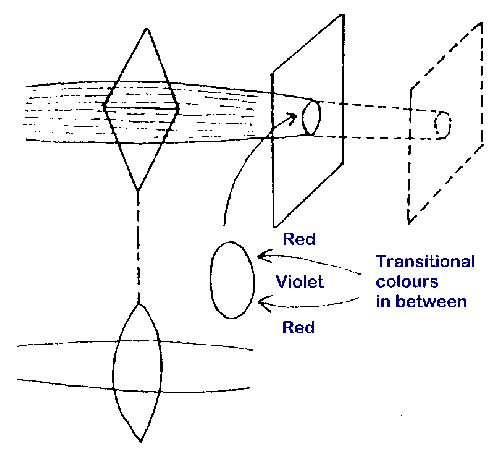
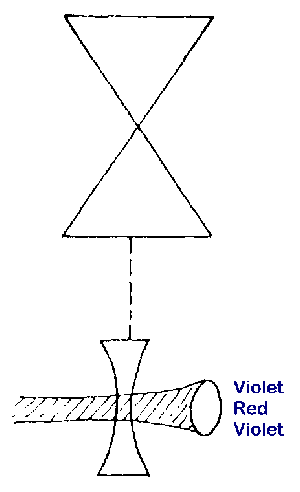
To draw it diagrammatically (Figure IIIa, above), here is a cylinder of light. I let the light go through the lens. If I confronted the light with an ordinary plate of glass or water, the cylinder of light would just go through and a simple picture of it on the screen would be the outcome. Not so if instead of the simple plate, made of glass or water, I have a lens. Following what has actually happened with my drawing, I must say: the picture has grown smaller. The cylinder of light is contracted.
Now there is also another possibility. We could set up a double prism, not as in the former instance but in cross-section as I am now drawing it (Figure IIIb),—the prisms meeting at the angle. I should again get the phenomenon described before, only in this instance the circle would be considerably enlarged. Once again, while moving the screen to and fro within a certain range, I should still get the picture—more or less indistinct. Moreover in this case (Figure IIIb, above and on the right) I should get violet and bluish colours both at the upper and at the lower edge, and red in the middle,—the opposite of what it was before. There would again be the intermediate colours.
Once more I can replace the double prism by a lens,—a lens of this cross-section (Figure IIIb). The other was thick in the middle and thin at the edges; this one is thin in the middle and thick at the edge. Using this lens, I get a picture considerably bigger than the cross-section of the cylinder of light would be without it. I get an enlarged picture, again with colours graded from the edge towards the centre. Following the phenomena in this case I must say: the cylinder of light has been widened,—very considerably thrust apart. Again: the simple fact.
What do we see from these phenomena? Evidently there is an active relation between the material—though it appears transparent in all these lenses and prisms—and what comes to manifestation through the light. We see a kind of interaction between them. Taking our start from what we should get with a lens of this type (thick at the edge and thin in the middle), the entire cylinder of light will have been thrust apart,—will have been widened. We see too how this widening can have come about,—obviously through the fact that the material through which the light has gone is thinner here and thicker here. Here at the edge, the light has to make its way through more matter than in the middle, where it has less matter to go through. And now, what happens to the light? As we said, it is widened out—thrust apart—in the direction of these two arrows. How can it have been thrust apart? It can only be through the fact that it has less matter to go through in the middle and more at the edges. Think of it now. In the middle the light has less matter to go through; it therefore passes through more easily and retains more of its force after having gone through. Here therefore—where it goes through less matter—the force of it is greater than where it goes through more. It is the stronger force in the middle, due to the light's having less matter to go through, which presses the cylinder of light apart. If I may so express myself, you can read it in the facts that this is how it is. I want you to be very clear at this point it is simply a question of true method in our thinking. In our attempts to follow up the phenomena of light by means of lines and diagrams we ought to realize that with every line we draw we ourselves are adding something which has nothing to do with the light as such. The lines I have been drawing are but the limits of the cylinder of light. The cylinder of light is brought about by the aperture. What I draw has nothing to do with the light; I am only reproducing what is brought about by the light's going through the slit. And if I say, “the light moves in this direction”, that again has nothing to do with the light as such; for if I moved the source of light upward, the light that falls on the slit would move in this way and I should have to draw the arrow in this direction. This again would not concern the light as such. People have formed such a habit of drawing lines into the light, and from this habit they have gradually come to talk of “light-rays”. In fact we never have to do with light-rays; here for example, what we have to do with is a cone of light, due to the aperture through which we caused the light to pass. In this instance the cone of light is broadened out, and it is evident: the broadening must somehow be connected with the shorter path the light has to go through in the middle of the lens than at the edge. Due to the shorter path in the middle, the light retains more force; due to the longer path at the edge, more force is taken from it. The stronger light in the middle presses upon the weaker light at the edge and so the cone of light is broadened. You simply read it in the facts.
Truth is that where we simply have to do with images or pictures, the physicists speak of all manner of other things,—light-rays and so on. The “light-rays” have become the very basis of materialistic thinking in this domain. To illustrate the point more vividly, we will consider another phenomenon. Suppose I have a vessel here (Figure IIId), filled with liquid—water, for example. On the floor of the vessel there is an object—say, a florin. Here is the eye. I can now make the following experiment. Omitting the water to begin with, I can look down at the object and see it in this direction. What is the fact? An object is lying on the bottom of the vessel (Figure IIIc). I look and see it in a certain direction. Such is the simple fact, but if I now begin explaining: there is a ray of light proceeding from the object to the eye, affecting the eye, and so on,—then, my dear Friends, I am already fancying all kinds of things that are not given.
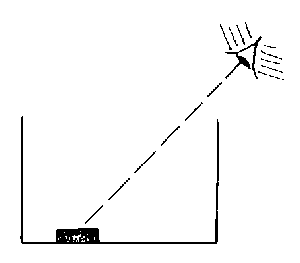
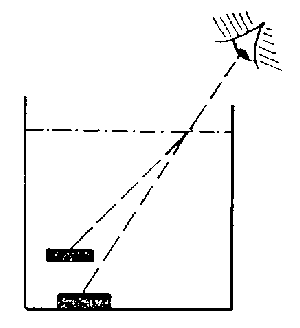
Now let me fill the vessel with water or some other liquid up to here. A strange thing happens. I draw a line from the eye towards the object in the direction in which I saw it before. Looking in this direction, I might expect to see the same as before, but I do not. A peculiar thing happens. I see the object lifted to some extent. I see it, and with it the whole floor of the vessel lifted upward. We may go into it another time, as to how this effect can be determined, by which I mean measured. I now only refer to the main principle. To what can this effect be due? How shall I answer this question, purely from the facts? Having previously seen the thing in this direction, I expect to find it there again. Yet when I look, I do not see it there but in this other direction. When there was no water in the vessel I could look straight to the bottom, between which and my eye there was only air. Now my sighting line impinges on the water. The water does not let my force of sight go through as easily as the air does; it offers stronger resistance, to which must give way. From the surface of the water onward I must give way to the stronger resistance, and, that I have to do so, comes to expression in that I do not see right down as before but it all looks lifted upward. It is as though it were more difficult for me to see through the water than through the air; the resistance of the water is harder for me to overcome. Hence I must shorten the force and so I myself draw the object upward. In meeting the stronger resistance I draw in the force and shorten it. If I could fill the vessel with a gas thinner than air (Figure IIIe), the object would be correspondingly lowered, since I should then encounter less resistance,—so I should push it downward. Instead of simply noting this fact, the physicists will say: There is a ray of light, sent from the object to the surface of the water. The ray is there refracted. Owing to the transition from a denser medium to a more tenuous, the ray is refracted away from the normal at the point of incidence; so then it reaches the eye in this direction. And now the physicists go on to say a very curious thing. The eye, they say, having received information by this ray of light, produces it on and outward in the same straight line and so projects the object thither. What is the meaning of this? In the conventional Physics they will invent all manner of concepts but fail to reckon with what is evidently there,—with the resistance which the sighting force of the eye encounters in the denser medium it has to penetrate. They want to leave all this out and to ascribe everything to the light alone, just as they say of the prism experiment: Oh, it is not the prism at all; the seven colours are there in the light all the time. The prism only provides the occasion for them to line up like so many soldiers. The seven naughty boys were there in the light already; now they are only made to line up and stand apart. The prism isn't responsible. Yet as we say, the colours are really caused by what arises in the prism. This wedge of dimness is the cause. The colours are not due to the light as such.
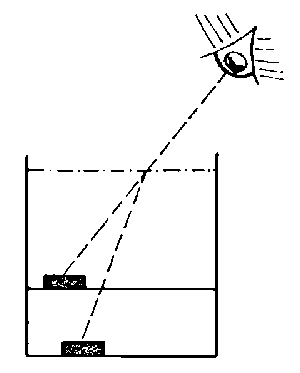
Here now you see it again. We must be clear that we ourselves are being active. We, actively, are looking with our eye,—with our line of sight. Finding increased resistance in the water, we are obliged to shorten the line of sight. What say the physicists on the other hand? They speak of rays of light being sent out and refracted and so on. And now the beauty of it, my dear Friends! The light, they say, reaches the eye by a bent and broken path, and then the eye projects the picture outward. So after all they end by attributing this activity to the eye: “The eye projects ...” Only they then present us with a merely phoronomical conception, remote from the given realities. They put a merely fancied activity in place of what is evidently given: the resistance of the denser water to the sighting force of the eye. It is at such points that you see most distinctly how abstract everything is made in our conventional Physics. All things are turned into mere phoronomic systems; what they will not do is to go into the qualities. Thus in the first place they divest the eye of any kind of activity of its own; only from outer objects rays of light are supposed to proceed and thence to reach the eye. Yet in the last resort the eye is said to project outward into space the stimulus which it receives. Surely we ought to begin with the activity of the eye from the very outset. We must be clear that the eye is an active organism.
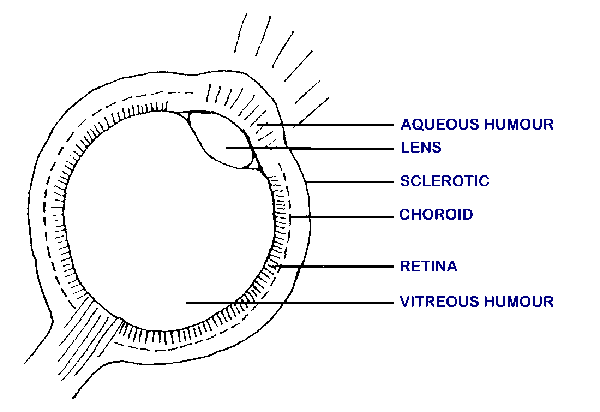
We will today begin our study of the nature of the human eye. Here is a model of it (Figure IIIf). The human eye, as you know, is in form like a kind of sphere, slightly compressed from front to back. Such is the eye-ball, seated in the bony cavity or orbit, and with a number of skins enveloping the inner portion. To draw it in cross-section (Figure IIIf). it will be like this. (When looking at your neighbour's eye you look into the pupil. I am now drawing it from the side and in cross-section.) This then would be a right-hand eye. If we removed the eye from the skull, making an anatomical preparation, the first thing we should encounter would be connective tissue and fatty tissue. Then we should reach the first integument of the eye properly speaking—the so-called sclerotic and the transparent portion of it, the cornea. This outermost integument (I have here drawn it) is sinewy,—of bony or cartilaginous consistency. Towards the front it gets transparent, so that the light can penetrate into the eye. A second layer enveloping the inner space of the eye is then the so-called choroid, containing blood-vessels. Thirdly we get the inner-most layer, the retina so-called, which is continued into the optic nerve as you go farther in into the skull. Herewith we have enumerated the three integuments of the eye, And now behind the cornea, shown here,—embedded in the ciliary muscle—is a kind of lens. The lens is carried by a muscle known as the ciliary muscle. In front is the transparent cornea, between which and the lens is the so-called aqueous humour. Thus when the light gets into the eye it first passes through the transparent cornea, then through the aqueous humour and then through this lens which is inherently movable by means of muscles. From the lens onward the light then reaches what is commonly known as the vitreous body or vitreous humour, filling the entire space of the eye. The light therefore goes through the transparent cornea, through the aqueous humour, the lens itself and the vitreous humour and from thence reaches the retina, which is in fact a ramification of the optic nerve that then goes on into the brain, This, therefore, (Figure IIIf),—envisaging only what is most important to begin with—would be a diagrammatic picture of the essential parts of the eye, embedded as it is in its cavity within the bony skull.
Now the eye reveals very remarkable features. Examining the contents of this fluid that is between the lens and the cornea through which the light first has to pass, we find it very like any ordinary liquid taken from the outer world. At this place in the human body therefore—in the liquid or aqueous humour of the eye, between the lens and the outer cornea,—a man in his bodily nature is quite of a piece with the outer world. The lens too is to a high degree “objective” and unalive. Not so when we go on to the vitreous body, filling the interior of the eye and bordering on the retina. Of this we can no longer say that it is like any external body or external fluid. In the vitreous humour there is decided vitality,—there is life. Truth is, the farther back we go into the eye, the more life do we find. In the aqueous humour we have a quite external and objective kind of fluid. The lens too is still external. Inside the vitreous body on the other hand we find inherent vitality. This difference, between what is contained in this more outward portion of the eye and what is there in the more contained parts, also reveals itself in another circumstance. Tracing the comparative development of the eye from the lower animals upward, we find that the external fluid or aqueous humour and the lens grow not from within outward but by the forming of new cells from the surrounding and more peripheral cells. I must conceive the forming of the lens rather in this way. The tissue of the lens, also the aqueous humour in the anterior part of the eye, are formed from neighbouring organs, not from within outward; whilst from within the vitreous body grows out to meet them. This is the noteworthy thing. In fact the nature of the outer light is here at work, bringing about that transformation whereby the aqueous humour and the lens originate. To this the living being then reacts from within, thrusting outward a more living, a more vital organ, namely the vitreous body. Notably in the eye, formations whose development is stimulated from without, and others stimulated from within, meet one-another in a very striking way.
This is the first peculiarity of the eye, and there is also another, scarcely less remarkable. The expanse of the retina which you see here is really the expanded optic nerve. Now the peculiar thing is that at the very point of entry of the optic nerve the eye is insensitive; there it is blind. Tomorrow I shall try to show you an experiment confirming this. The optic nerve thence spreads out, and in an area which for the right-hand eye is a little to the right of the point of entry the retina is most sensitive of all. We may begin by saying that it is surely the nerve which senses the light. Yet it is insensitive to light precisely at its point of entry. If it is really the nerve that senses the light we should expect it to do so more intensely at the point of entry, but it does not. Please try to bear this in mind.
That this whole structure and arrangement of the eye is full of wisdom—wisdom, if I may so put it, from the side of Nature—this you may also tell from the following fact. During the day when you look at the objects around you—in so far as you have healthy eyes—they will appear to you more or less sharp and clear, or at least so that their sharpness of outline is fully adequate for orientation. But in the morning when you first awaken you sometimes see the outlines of surrounding objects very indistinctly, as if enveloped with a little halo. The rim of a circle for example will be indistinct and nebular when you have just awakened in the morning. What is it due to? It is due to there being two different kinds of things in our eye, namely the vitreous body and the lens. In origin, as we have seen, they are quite different. The lens is formed more from without, the vitreous body more from within. While the lens is rather unalive, the vitreous body is full of vitality. Now in the moment of awakening they are not yet adapted to one-another. The vitreous body still tries to picture the objects to us in the way it can; the lens in the way it can. We have to wait till they are well adapted to each other. You see again how deeply mobile everything organic is. The whole working of it depends on this. First the activity is differentiated into that of the lens and the vitreous body respectively. From what is thus differentiated the activity is thereupon composed and integrated; so then the one has to adapt itself to the other.
From all these things we shall try gradually to discover how the many-coloured world emerges for us from the relation of the eye to the outer world. Now there is one more experiment I wish to shew today, and from it we may partly take our start tomorrow in studying the relation of the eye to the external world. Here is a disc, mounted on a wheel and painted with the colours which we saw before—those of the rainbow: violet, indigo, blue, green, yellow, orange and red. First look at it and see the seven colours. We will now bring it into rotation. I can turn fairly quickly and you still see the seven colours as such—only rotating. But when I turn quickly enough you can no longer see the colours. You are no doubt seeing a uniform grey. So we must ask: Why do the seven colours appear to us in grey, all of one shade? This we will try to answer tomorrow. Today we will adduce what modern Physics has to say about it,—what is already said in Goethe's time. According to modern Physics, here are the colours of the rainbow: red, orange, yellow, green, blue, indigo, violet. We bring the disc into rotation. The single impression of light has not time enough to make itself felt as such in our eye. Scarcely have I seen the red at a particular place, the quick rotation brings the orange there and then the yellow, and so on. The red itself is there again before I have time to rid myself of the impressions of the other colours. So then I get them all at once. The violet arrives before the impression of the red has vanished. For the eye, the seven colours are thus put together again, which must once more give white.
Such was the scientific doctrine even in Goethe's time, and so he was instructed. Bring a coloured top into quick enough rotation: the seven colours, which in the prism experiment very obediently lined up and stood apart, will re-unite in the eye itself. But Goethe saw no white. All that you ever get is grey, said Goethe. The modern text-books do indeed admit this; they too have ascertained that all you get is grey. However, to make it white after all, they advise you to put a black circle in the middle of the disc, so that the grey may appear white by contrast. A pretty way of doing things! Some people load the dice of “Fortune”, the physicists do so with “Nature”—so they correct her to their liking. You will discover that this is being done with quite a number of the fundamental facts.
I am trying to proceed in such a way as to create a good foundation. Once we have done this, it will enable us to go forward also in the other realms of Physics, and of Science generally.

